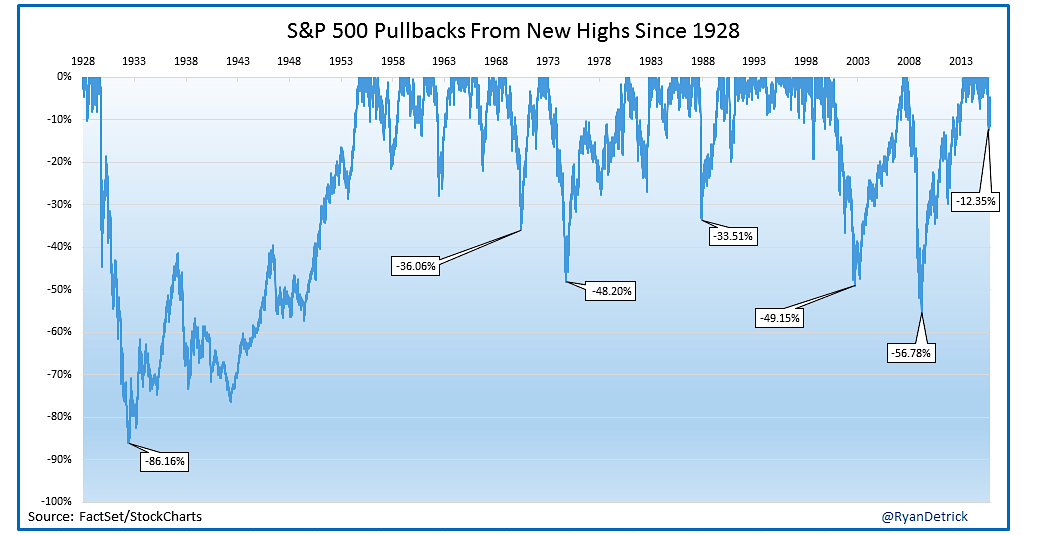October 2019 update by the legend, Professor Damodaran
Short answer: no, never. The stock market, or Mr. Market as Benjamin Graham would call it, never needs to do anything bullish, bearish, up, down, sideways…. Keynes said it best: “markets can stay irrational longer than you can stay solvent.” People run around CNBC, Bloomberg, your local watering hole, etc. claiming stock markets are at dangerous levels and are due for a pullback. Most of the time you hear this, talking heads say markets are “overextended” because they have rallied for a relatively long time without pulling back for a correction.
By definition, these opinions are based on technicals rather than fundamentals. Some technical indicators can pass for timing devices from the nature of their setup or origination. But comments solely based on historical context do not fit that bill. The talking heads are usually wrong 15 out of 12 times, more on that math later. Some examples of recent doomsday talk: this bull market hasn’t corrected once since…, it’s been too long without a pullback, P/E’s are historically high, this is the longest bull market ever.
We don’t define pullbacks as the 2-3% that freaks people out in the current reduced volatility environment. Anything less than 10% is just noise; even 5% is….meh. Some fundamentalists could argue that anything less than 20% is just noise as well – this is a question of time horizon and trading style though. Fundamentalists tend to be long-term investors, and 10-15% pullbacks tend to correct themselves as the broad market pulls down individual businesses. If you’re a long-term investor and believe in these individual stocks’ business models, then earnings should return and you don’t want to jump ship every time the broad market sells off. All said, if you are a long-term investor then there is no need to worry about the imminent 3-5+ corrections you will see over your 20-30+ year investing horizons. None of these will change the fundamental reasons for you to hold the equity portion of your portfolio. Markets go up and down, they will recover. The S&P 500’s return over any rolling 20 year period since 1928 has never been negative, in fact. Read more about that here.
As for the shorter-term investors, significant technical pullbacks are triggered by fundamental reasons. Technicals are just a tool which might tip off future moves. Translation, fundamentals drive market returns, not technical comments or comments based on technicals such as “we’re due for a pullback.” More often than not, these are false positives – they tip off moves which never come. Hence, the people calling for a pullback are wrong 15 out of 12 times because they’ve called for so many corrections that have never amounted to anything. They are the ones constantly crying wolf, beware of them.
Shorter-term investors with a very short horizon, such as day-traders, probably can’t handle 2-3% pullbacks so they need to have a quick trigger to avoid these. Most people aren’t day-traders though. Short to mid-term traders, swing traders of sorts, might be better off hedging against 5-10% moves because they can handle 2-3% pullbacks as buying opportunities.
Here’s some actionable advice so you don’t freak out every time the market makes a move greater than 3-5%. Some feasible hedges:
- Buy puts – time horizon is key here, and runaway markets would cause you to lose protection of a lot of your gains (e.g. – you buy SPY puts with 200 strike while SPY is at 210, SPY goes to 240 and now you have no protection for the 30 points just gained)
- buy puts to your specific stock positions
- buy broad market puts (SPY, etc)
- Buy VIX calls – my favorite when the VIX is super low around 9-11, and changes with relative history (12-14 is historically low)
- the VIX has a floor built in around 9 so even runaway markets won’t mean that your protection is compromised (volatility always exists and will never go below a certain point – that point seems pretty set around 9)
- Set up long/short pair trades
- if you own Citigroup or Goldman Sachs, then sell another bank you don’t like as much against it
- when the market goes down, the short position will profit and hopefully your call is right as it will go down more than your long position
- click here for more on pairs trading
- Worst idea – buy inverse funds
- these are a decaying asset and only meant to reflect daily moves in broad market indices
- here’s a short article about that
Takeaways:
1) Mr. Market doesn’t “need” to do anything
2) Factor in your investment horizon and then decide how worried to get about potential “pullbacks” and actual pullbacks
3) Hedge accordingly….only if you need to do so
4) We are not permabulls. Markets and fundamentals dictate action. Absence of action does not dictate action.
NOTE: We’re neither bullish nor bearish on the current market. But here’s a new bull logo:







I just read this today and thought of your post how nothing NEEDS to happen in the market….I guess it’s catching on??
http://www.dailywealth.com/3652/when-stocks-just-can-t-go-higher-
It’s funny how media and some finance people since last 5 years have been constantly saying that bitcoin is gonna blow up but the only direction it goes is north.
Oct 2019 update – whooooooops